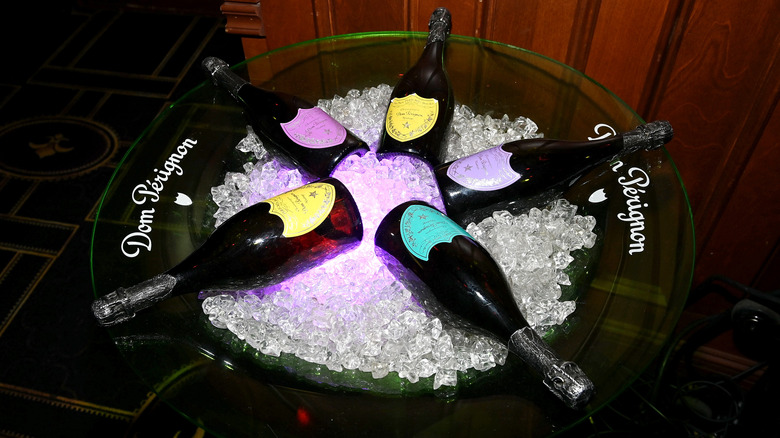Dom Pérignon: How The Iconic Champagne Got Its Name
Champagne is the height of luxury when it comes to alcoholic beverages, a fizzy concoction with distinct and delicate flavors that pair perfectly with any special occasion. And within the world of champagne, there's one name that stands above all others. Dom Pérignon is a ludicrously expensive brand for a reason, after all, and frequently memorialized in popular culture. But how did Dom Pérignon get its name, anyway? The name almost sounds like it was named after a person.
Well, that's because it actually was. Dom Pérignon was a real guy who lived nearly half a millennia ago in France, and whose contributions to the art of champagne-making can't be overstated. This is one of those instances where a product is named after the person who deserves full credit for developing it because Dom Pérignon quite literally devoted his life to making the perfect champagne. We all know the "if it doesn't come from the Champagne region of France, it's just sparkling wine" meme, but champagne really was invented in Champagne, where Dom Pérignon himself came from.
Dom Pérignon made a ton of advances in wine-making
Born in 1638 to a large family, Pérignon entered the church at age 19 and never looked back until his death at age 77. Pérignon didn't invent sparkling wine generally, but he did make significant contributions to its improvement during the course of his life, including figuring out how to produce white wine from red grapes, using English glass, and the re-introduction of corks as a viable stopper for wine. That story about champagne being invented on one specific night in 1693 is almost certainly made up, but the dude made a ton of advances in the field.
Most importantly, though, he figured out how to keep sparkling wine bottles from exploding due to CO2 buildup (a problem even Snapple manufacturers would be dealing with centuries later). This was ultimately what allowed him to have such huge renown for champagne specifically — well, that and his business sense. Pérignon knew how to promote his product, with wine bearing his name making its way across Europe. This was his other genius move, as it was the first time a product like wine had been attached to the name of its manufacturer.
From there, the reputation of his champagne grew over the course of centuries to the point where it became associated with luxury. Today, the monastery where he originally made his advances, the Abbey d'Hautvillers, is owned by champagne-maker Moët & Chandon (who also own the Dom Pérignon name).
Historically, monks producing alcohol is pretty common
It's important to note that a Catholic monk being heavily involved in the pursuit of alcoholic science isn't an outlier, here; this happened a lot, historically. It was actually very common for guys living in monasteries to devote their lives to perfecting recipes, in large part because they tended to have a lot of free time and nothing in the Bible forbids brewing. Beer was a big one; though the history of beer dates back millennia, it became really big in monasteries in the Middle Ages — in part because it was safer to drink than water at the time. Wine was no different, and even today there are monasteries in European countries that specialize in wine-making.
Given the history, it's no surprise the best champagne we have came from a monk. Still, we owe Dom Pérignon and his life's work a debt of gratitude.


